Abstract
In this study, we used density functional theory (DFT) and natural bond orbital (NBO) analysis to determine the structural, electronic, reactivity, and conformational features of 2,5,5-trimethyl-1,3,2-di-heteroatom (X) phosphinane-2-sulfide derivatives (X = O (compound 1), S (compound 2), and Se (compound 3)). We discovered that the features improve dramatically at 6-31G** and B3LYP/6-311+G** levels. The level of theory for the molecular structure was optimized first, followed by the frontier molecular orbital theory development to assess molecular stability and reactivity. Molecular orbital calculations, such as the HOMO–LUMO energy gap and the mapping of molecular electrostatic potential surfaces (MEP), were performed similarly to DFT calculations. In addition, the electrostatic potential of the molecule was used to map the electron density on a surface. In addition to revealing molecules’ size and shape distribution, this study also shows the sites on the surface where molecules are most chemically reactive.
1. Introduction
Chemical compounds containing organic segments that are bonded to phosphorus either directly or indirectly (e.g., via sulfur, oxygen, or nitrogen) are known as organo-phosphorus compounds (OPs) [1]. They are one of the most commonly encountered compounds and are used worldwide in a variety of agricultural [2], industrial [3], medical [4], and veterinary applications [5]. In the 19th century, the first OPs were synthesized by Lassaigne and Clermont [4]. Insecticides and chemical warfare agents were created in the 20th century by Gerhard Schrader. Chemical warfare agents, eye medications, pesticides, and lubricants are manufactured from OPs. Most researchers have recently been interested in computational methods to detect chemical species evidence [6,7,8]. Theoretical approaches are often used to study chemical processes and the molecular characteristics of compounds. Aside from that, theoretical approaches are often used to determine newly synthesized chemical species [9,10]. This work aims to thoroughly study the computational calculation for 2,5,5-trimethyl-1,3,2-dihetereophosphinane-2-sulfide, where the heteroatom is one of the O, S, or Se atoms. No theoretical studies have yet been performed on 2,5,5-trimethyl-1,3,2-dihetereophosphinane-2-sulfide and its derivatives.
The conformational equilibrium is influenced by stereoelectronic interactions, which have long been recognized [11,12]. However, Praly and Lemieux define anomeric effect (AE) based on a difference between equatorial (eq.) and axial (ax.) conformers’ total endo- and exo-anomeric effects [13,14]. This phenomenon is known as a “Generalized Anomeric Effect” (GAE) or “negative hyperconjugation” [12]. Experimental and theoretical approaches were used for the in-depth study of the AE [15,16]. Furthermore, depending on the relative amount of the distinct GAEeq. and GAEax. contributions to the total GAE, the GAE associated with electron delocalization can have negative or positive values [17]. As a result, Equation (1) can compute the total GAE for components (1–3) [18,19].
The GAE influences the reactivity and conformational behavior of saturated heterocyclic systems [20]. Although several literature reports argue for the primary importance of electrostatic factors, Wiberg and Rable acknowledge the complexity of the AE but advocate for the greater importance of bond polarization and electrostatics [21]. In addition, Mo and co-workers use Block Localized Wavefunction (BLW) analysis to disprove the hyperconjugation explanation for the GAE [22,23]. Then, several authors accept the existence of hyperconjugation but conclude that the electrostatic effects are more effective than hyperconjugation. Many studies on the conformations of six-membered rings, including phosphorus and sulfur, have provided convincing evidence that GAE can propagate through centers other than carbon atoms [24,25,26]. The more likely an electron donor is to donate to an electron acceptor, the more conjugation throughout the system. It will happen when the electron density moves from a Lewis-type NBO orbital (lone pair or bond) to an orbital that should be unoccupied (Rydberg or anti-bond). In this case, the donor–acceptor interaction keeps the electron density stable. The anomeric effect changes the conformational equilibrium around the anomeric center. It also changes the stereochemical output of several events at the anomeric center. As a result, the stereoelectronic interactions of n(X)®σ*(P-S)app (P=S orientation is ax.) and n(X)®σ*(P-C)app (P=C orientation is eq.) (X = O, S, and Se) were investigated. The 1,3,2-dioxaphosphorinane derivatives are interesting compounds because of their biological activities [27,28]. Numerous studies of the structures and conformations of 1,3,2-dioxaphosphorinanes and related heterocycles have been reported [29,30,31,32]. They demonstrated that anti-bonding orbitals play a role in molecules with low acceptor orbitals, such as the P=O or P=S. However, the structural, electrical, and reactive properties of these compounds, which have been examined in the literature, are limited and need more investigation.
Herein, we study the structural, reactivity, and conformational (ax. ⇌ eq.) features of the 2,5,5-trimethyl-1,3,2-di-heteroatom phosphinane-2-sulfide derivatives (Scheme 1, heteroatoms = O (-oxa-), S (-thia-), and Se (-selena-)). These compounds were studied computationally using the DFT approach and natural bond orbital (NBO) analyses. These analyses were used to examine the effects of different hetero atoms in rings with different P=S orientations (ax. ⇌ eq.) and the anomeric effect in 1,3,2-dihetereo-2-sulfide (as an example of O, S, and Se-substituted analogs) on the anomeric effect. After that, compounds’ chemical reactivity and reactive site selectivity (1–3) were thoroughly investigated using DFT, molecular electrostatic potential, and density of states (DOS).
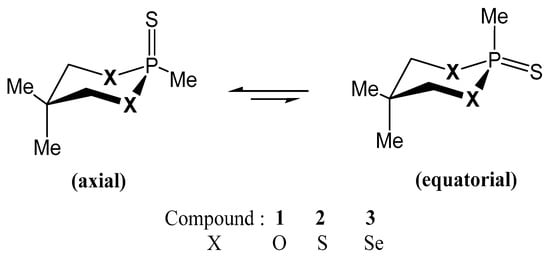
Scheme 1.
Schematic illustration between (ax. ⇌ eq.) forms of compounds 1–3.
It should be known that compounds’ conformational properties affect stabilization energies. It was interesting to study the stabilization energies correlated with the electronic delocalization and the electronic structures of the model compounds (1–3) by NBO analysis [33,34,35]. The stabilization energies obtained with electronic delocalization neqX®σ*P-S, naxX®σ*P-S, naxX®σ*P-C, σX-C6®σ*P-C, σX-C6®σ*P-S, neqS®σ*P-X, and neqS®σ*P-C are shown in Scheme 2.
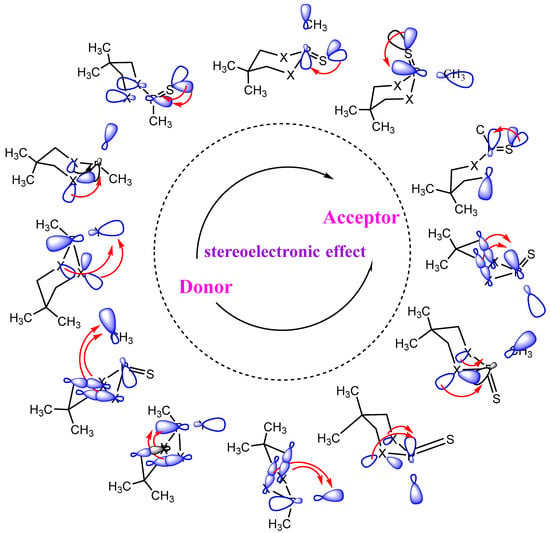
Scheme 2.
A diagram exhibiting the changes in electronic delocalization between orbitals (donor-acceptor) throughout (ax. ⇌ eq.) conformations of 2,5,5-trimethyl-1,3,2-di-heteroatom (X) phosphinane-2-sulfide.
2. Computational Models
The compounds (1–3) were thoroughly optimized using Gauss-View 5.0 molecular visualization software from Gaussian 03 software at the B3LYP/6-31G and B3LYP/6-311+G** levels of theory. For all computations, the DFT technique was used, which combines Becke’s hybrid gradient-corrected (three-parameter nonlocal) exchange functional [36] with Lee, Yang, and Parr’s gradient-corrected (nonlocal) correlation functional [37]. The natural bonding orbitals (NBO) 3.1 program was then used to perform an NBO analysis ax. ⇌ eq. conformations of compounds. NBO studies, including orbital population, Wiberg bond orders, and charge transfer stabilization energies at the identical B3LYP/6-31G** and B3LYP/6-311+G** levels, were conducted using the NBO 3.1 program, which is part of the Gaussian 03 software package [38].
3. Results and Discussion
3.1. Conformational Preferences
The compounds (1–3) in the chair conformations are more stable in the B3LYP approach than in the twist-boat conformations. As shown in Figure 1 and Figure 2, the total corrected energies (ΔE0, Hartree), the differences in enthalpies (ΔH, kcal mol−1), entropies (ΔS, cal mol−1 K−1), and Gibbs free energy (ΔG, kcal mol−1) at the standardized conditions (25 °C, 1 atm) between the ax. ⇌ eq. conformations for compounds (1–3) were calculated at the levels of B3LYP/6-311+G** and B3LYP/6-31G**. Interestingly, ΔG values in the ax. conformations are lower than in eq. conformations. This is true for all methods used in this study, using complete geometry optimization.
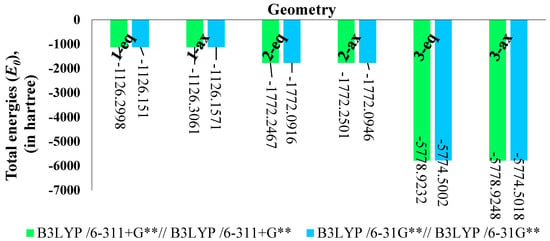
Figure 1.
Total energies (E0, in Hartree) that are calculated for the (ax. ⇌ eq.) conformations of compounds (1–3).
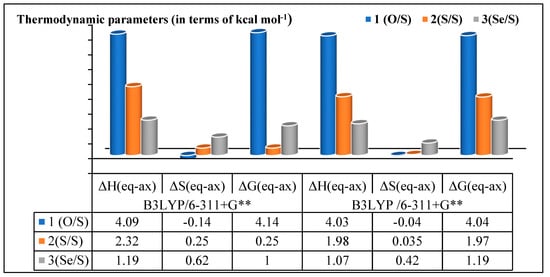
Figure 2.
The B3LYP/6-311+G//B3LYP/6-311+G and the B3LYP /6-31G//B3LYP/6-31G calculated thermodynamic characteristics (∆H, ∆S, and ∆G) for the (ax. ⇌ eq.) conformations of compounds 1–3.
As shown in Figure 3, the calculated ΔGeq-ax values for compounds at the B3LYP/6-311+G level were somewhat like the ΔGeq-ax values obtained at the B3LYP/6-31G level. ΔGeq-ax values between (ax. ⇌ eq.) conformations at the B3LYP/6-311+G level of theory were found to be 4.14, 0.25, and 1.00 kcal mol−1 for compounds (1), (2), and (3), respectively. However, ΔGeq-ax values for compounds (1), (2), and (3) at the B3LYP/6-31G** level were calculated to be 4.04, 1.97, and 1.19 kcal mol−1, respectively. Notably, there is an apparent agreement between these sequences with the experimental data published in the literature for compound (1) [39]. Further, it is shown that the preference for ax. conformations compared to their equivalent eq. conformations decrease from compound (1) to compound (3).
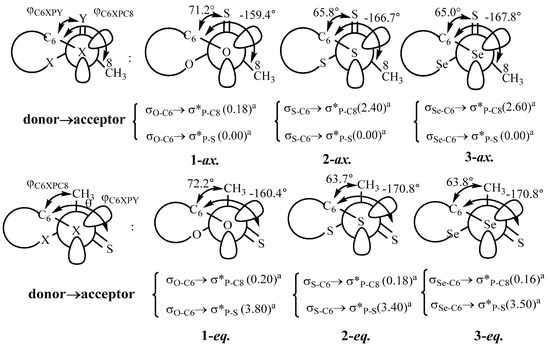
Figure 3.
Newman projection of donor–acceptor orbitals of the compounds (1–3) in their (ax. ⇌ eq.) conformations. (a stabilization energy values; kcal mol−1).
Since the hyperconjugation of two electrons and orbitals occurs, stabilization is significant [40]. The effect of the molecule geometry on the energy gap, the ability of the empty orbital to receive, and the ability of the filled orbital to donate are essential parts of this scenario [41,42]. The resonance values of the energies related to naxX®σ*P-Selectron delocalization are 12.48, 9.86, and 8.12 kcal mol−1 for the ax. conformations of compounds (1), (2), and (3), respectively. These stereoelectronic orbital interaction forms also indicate the preference of compounds (1–3) more efficiently for the ax. conformation. In addition, Generalized Anomeric Effects (GAE) values for compounds (1), (2), and (3) are 5.56, 3.40, and 2.90 kcal mol−1, respectively.
The stereoelectronic effects, which correlated to n2X→σ*P-C electron delocalization in the eq. conformations and the n2X→σ*P-S electron delocalization in the ax. conformations, have the most considerable degree of stability energy. The orientation of the electron’s lone pairs of the O, S, and Se atoms in the heterocyclic ring and the P-C (in eq. conformations) or P-S (in ax. conformations) for anti-bonding orbitals is antiperiplanar (ap) (Figure 3). Several factors influence stereoelectronic effects, such as the difference in energy between the overlapping donor–acceptor orbitals and their presence in a synclinal arrangement (sc) [43,44]. As a result, the σX-C6→σ*P-C8 and σX-C6→σ*P-S electron delocalization, as depicted in Figure 3, cannot have high stability energy. For this reason, the stability energy values of delocalization for compounds (1–3) in the ax. conformations are not very important.
It is worth noting that the calculated stabilization energies associated with σX-C6→σ*P-S electron delocalizations for the eq. conformations of compounds (1–3) are 3.80, 3.40, and 3.50 kcal mol−1, respectively, and do not exist for the ax. conformations. Moreover, the electron delocalization of σX-C6→σ*P-C8 in the ax. conformation increased from compound (2) towards compound (3), compared to the value of X = O, which may be due to larger amounts of s-character and electronegativity [45], and the values decreased in the eq. conformations from compound (1) to (3). Stereoelectronic effects are negligible in eq. conformations, while the stability energies of electronic transitions for ax. conformations are significant. According to NBO studies and thermodynamic data, stereoelectronic interactions have an important influence on compounds’ behavior.
Further, the results indicate that the values of GAE are more vital for analyzing the conformational preferences of these compounds than the electrostatic effects, which are less significant. Further, the results indicate that the values of GAE are more vital for analyzing the conformational preferences of these compounds than the electrostatic effects, which are less significant. The dipole moment of compounds was also looked at in both (ax. and eq.) orientations using the B3LYP/6-311+G computational method.
3.2. Bond Order and Structural Parameters
It is possible to relate the delocalization of electrons to structural factors, such as the Wiberg Bond Index (WBI) term, which is the sum of squares between off-diagonal density matrix components linking atoms, using the natural atomic orbitals (NAO) [46,47]. The findings revealed that compound (1) has an ax’s low (nax.X→σ*P-S) electron delocalization conformations compared to compound (3), indicating a weakness in the covalent character [48]. In contrast, it increases the WBI value of P-X, whereas compound (3) decreases it, as shown in Figure 4. In addition, compound (3) has a low WBI(eq-ax) value for P=S, indicating that P=S is increasingly difficult to calculate. For the compounds examined, both the WBI(P-X) values and GAE agree with each other.

Figure 4.
WBI and ΔWBIeq-ax calculation in (ax. ⇌ eq.) conformations of compounds (1–3) at B3LYP/6-311+G level.
3.3. HOMO–LUMO Analysis
Both HOMO and LUMO are crucial parameters in quantum chemistry [49,50]. Typically, the ionization potential (Eion.) is related to the HOMO energy, while LUMO energy is proportionate to an electron affinity (Eaff.) [51,52]. The HOMO–LUMO energy gap is derived by subtracting the HOMO and LUMO energy levels. When the energy gap is large, it suggests that the molecule has high kinetic stability and minimal chemical reactivity [53]. Furthermore, there is a relationship between the change in the binding nature of the orbitals engaged in the electronic transition and the bond distance change for each pair of bond atoms. Figure 5 depicts the energy levels of the HOMO–LUMO boundaries for compounds (1–3). It was used to measure the electronegativity (χ), chemical potential (µ), chemical hardness (η) and softness (S), global electrophilicity index (ω), and the measurements are presented in Figure 6. The formula for determining the calculated parameters is disclosed in Equations (2)–(5) as follows [54,55].
χ = −0.5 (EHOMO + ELUMO) = − μ
η = −0.5 (EHOMO − ELUMO)
S = 2η−1
ω = μ2/2η

Figure 5.
HOMO–LUMO patterns in (ax. ⇌ eq.) conformations for compounds (1–3) at B3LYP/6-311+G.
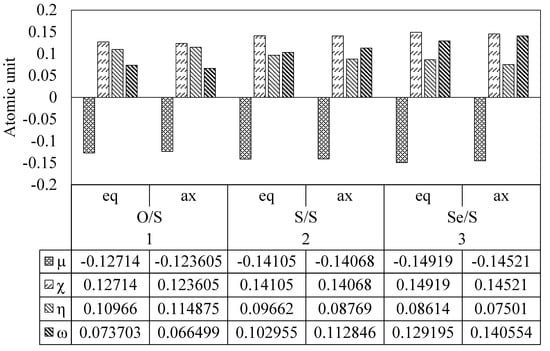
Figure 6.
Computed quantum chemical parameters for (ax. ⇌ eq.) conformations of compounds (1–3) at the B3LYP /6-311+G level.
The purpose of the HOMO–LUMO analysis was to explore the impact of substitution (O, S, and Se) atoms on the electronic structure of the 2,5,5-Trimethyl-1,3,2-Diheterophosphinane-2-Sulfide compound. Results suggest a sensitivity of the HOMO–LUMO gap to the type of heteroatom. It was noted that the presence of O atom in the compound can reduce the HOMO–LUMO gap in eq. conformation. In contrast, S and Se atoms could increase the HOMO–LUMO gap in eq. conformation. The conclusion is that the effect of the atoms in the compound cannot be ignored when figuring out what the band gap means. Furthermore, HOMO–LUMO plots were employed to examine the compound’s hardness of chemical, chemical potential, and electro-negativity. The energy of the highest occupied molecular orbital (EHOMO) and the energy of the lowest unoccupied molecular orbital (ELUMO) are utilized in the Equations (2)–(5), based on the Koopmans approximation. These parameters are reactivity descriptors and electronic properties. A good, more reactive, the nucleophile is characterized by a lower value of μ and ω. A good electrophile is characterized by a high value of μ and ω.
The thermodynamic characteristics (∆H, ∆S, and ∆G) values in compound 1 are higher than in compounds 2 and 3. Thus, the ax. conformation has higher reactivity than the analogous eq. conformation (Figure 2), and the ∆EL-H value decreases as the intruding heteroatom inside the ring (O→S→Se) switches from compound (1) to compound (3) in both (ax. ⇌ eq.) conformations. Depending on the η values, wide HOMO–LUMO gaps suggest a rigid molecule, while tiny gaps indicate a soft molecule, which is also more reactive than one with wide gaps. This property is crucial, for example, to understand the many types of pollutants in terms of how quickly they react and how well they attack specific sites [56]. It can be seen from Figure 6 that (ax. ⇌ eq.) conformation of compound (1) is almost reactive with high hardness values. Furthermore, the low ω values in the (ax. ⇌ eq.) conformation of compound (1) demonstrate electrons’ strong current from the donor moiety to the acceptor. It is important to understand that the energy gaps also reflect how charge transfer occurs within compounds, which affects biological activity, for example, and is a measure of the excitability of the molecule.
The electronegativity and hardness are used extensively to predict the chemical behavior of the compounds. A hard molecule has a large HOMO–LUMO gap and a soft molecule has a small HOMO–LUMO. The LUMO represents electron(s) accepting ability and HOMO as electron donating ability of a molecule. Therefore, the 1-ax. confirmation should be a better nucleophile than 2-ax. and 3-ax.
In comparison to other geometries, the 3-ax. conformation has a smaller energy gap (4.0805 eV) between the frontier molecular orbitals. This makes it easier for the charge to transfer [57]. As a result, the HOMO–LUMO bandgap has narrowed due to the electron-acceptor group’s strong electron-accepting capacity.
3.4. Molecular Electrostatic Potential (MEP) and Density of States (DOS) Analysis
The MEP surface is a property of electronic density that is a critical determinant of atomic and molecular possession [58]. Hence, MEP has mainly been employed to describe the chemical reactivity of several biological systems involved in electrophilic and hydrogen bonding interactions [59,60]. MEP diagram is essential for researchers looking into the physicochemical characteristics of molecules since it shows the molecule size, shape, and negative, positive, and natural electrostatic potentials [61]. It was used to figure out where nucleophilic and electrophilic attacks will most likely [62]. At each given r′(x, y, z) point, MEP V(r′) is defined as the energy of the interaction between a positive test charge (a proton) and the electric charge generated by the molecule’s electrons and nuclei, and it can be calculated via Equation (6).
where V(r′) is the electrostatic potential at r′, Zα is the charge on the nucleus allocated at Rα, and ρ(r′) is the electron density (the first term is due to the nuclear charge and the second to the electronic distribution).
Distinct colors indicate different electrostatic potential values at the surface; red and blue regions in the MEP signify electron-rich and electron-poor regions, respectively; green represents the neutral electrostatic potential [63]. The electrophilic attack region is red (P=S group in ax. conformations of compounds 1–3) in most MEP diagrams, whereas the nucleophilic attack region is blue (hydrogen atoms). Negative V(r′) regions are often associated with a single pair of electronegative atoms. As seen by the MEP map of the title molecule, areas with a negative potential are located over electronegative atoms (oxygen and phosphorus), whereas regions with a positive potential are located over hydrogen atoms. These locations provide information about where the chemicals may interact intermolecularly.
Figure 7 shows the MEP surfaces using a color code between −3.748 × 10−2 a.u (deepest red) to 3.748 × 10−2 a.u (deepest blue) for ax. conformations and between −4.594 × 10−2 a.u to 4.594 × 10−2 a.u for eq. conformations of compounds (1–3) at the B3LYP/6-311+G** level of theory. Figure 7 reveals that hydrogen atoms exhibit the greatest affinity for nucleophilic attacks, whereas oxygen atoms exhibit the greatest repulsion. In addition, the generated surface shows the molecule size, shape, and electrostatic potential value concurrently. The areas related to the (P = S)ax. group in ax. conformations have a darker red color than the (P = S)eq. group in eq. conformations, which means that the ax. conformations are more reactive than the eq. ones to electrophilic attack. Furthermore, the area in red in compounds 1 to 3 is decreasing. From compounds 1 to 3, the reactivity of electrophilic reactions is declining.
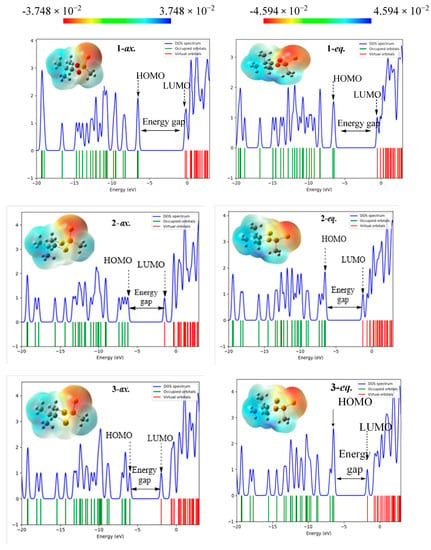
Figure 7.
Representation of the MEP diagram and DOS for (ax. ⇌ eq.) conformations of compound (1–3) at B3LYP/6-311+G.
The density of state (DOS, Figure 7) graph was constructed for each compound in the ax. and eq. conformations. The most common use of DOS graphs is to visualize molecular orbitals, their bonded, anti-bonded, or non-bonded nature, and their interactions [64,65]. These green and red graphs represent occupied and unoccupied regions, respectively. The energy differences between HOMO and LUMO are comparable to the values determined by DFT calculations.
Finally, DFT calculation and NBO analysis provided a clear view from a stereoelectronic perspective of the conformational priority in 2,5,5-trimethyl-1,3,2-dioxaphosphinane 2-selenide, -dithiaphosphinane 2-selenide, and -diselena phosphinane 2-selenide compounds, as reported in our recent work [66]. The findings revealed that thermodynamic properties with steric effects play a minimal role in explaining conformational behaviors of compounds, while stereoelectronic effects dominate in the justification of conformational behaviors. The anomeric effect and the electrostatic model were shown to be more successful than other effects in predicting the conformational behavior of compounds (1–3) in this study. Interestingly, conformational preference was best explained using GAE rather than electrostatic. Consequently, the GAE effects significantly control the conformational priority of compounds (1–3). Therefore, the results of this work are consistent with previously reported work. In addition, the results of DFT calculations are a good tool for predicting stereoelectronic behavior and anomeric effects, and the conformational behavior of the compounds could reasonably account for the electrostatic interactions.
4. Conclusions
In conclusion, the stability of 2,5,5-trimethyl-1,3,2-di-heteroatom (X) phosphinane-2-sulfide derivatives (X = O, S, and Se) corresponding to their ax. and eq. conformers was evaluated. The compounds were analyzed employing the DFT approach and the NBO interpretation. It was found that the ax. chair conformations are more stable than their corresponding eq. conformations, which could be the reason for the ax. conformational preferences. Furthermore, thermodynamic parameters revealed that steric effects contribute to the reasoning of compound conformational behaviors and that stereoelectronic effects are prominent in steric effects based on conformational behaviors. As a result, the enhanced stability of the relevant confirmation was ascribed to the generalized anomeric effect. The calculated GAE values are more important than the electrostatic effects when figuring out how these compounds like to be in a different geometry. Conformational preference was best explained using GAE rather than electrostatic or steric influences. Calculations were also made for the HOMO–LUMO energy gap and other molecular characteristics. Based on their interpretation of the structure–activity connection, the molecular electronic and nucleophilic centers may be deduced from the molecule’s interior center. In this way, it was shown how the parameters could help understand the compounds’ conformational and chemical properties.
Author Contributions
Conceptualization, N.M.; methodology, N.M. and Z.M.; software, N.M. and M.R.T.; validation, Z.M., H.S.A. and M.R.T.; formal analysis, N.M. and G.A.M.A.; investigation, M.R.T. and H.S.A.; resources, Z.M..; data curation, H.S.A. and Z.M.; writing—original draft preparation, N.M. and M.R.T.; writing—review and editing, A.V.S., and G.A.M.A.; visualization, A.V.S. and G.A.M.A.; supervision, A.V.S. and G.A.M.A.; project administration, G.A.M.A.; funding acquisition, N.M. and A.V.S. All authors have read and agreed to the published version of the manuscript.
Funding
This research received no external funding.
Institutional Review Board Statement
Not applicable.
Informed Consent Statement
Not applicable.
Data Availability Statement
The data presented in this study are available in the article.
Acknowledgments
N.M. would like to thank the Chemistry Department of Roudehen Branch, Islamic Azad University, for financial support. In addition, A.V.S. acknowledges the financial support from the Ministry of Science and Higher Education of the Russian Federation (State assignment in the field of scientific activity, No 0852-2020-0019.
Conflicts of Interest
The authors declare no conflict of interest.
References
- Yao, J.; Wang, Z.; Guo, L.; Xu, X.; Liu, L.; Xu, L.; Song, S.; Xu, C.; Kuang, H. Advances in immunoassays for organophosphorus and pyrethroid pesticides. TrAC Trends Anal. Chem. 2020, 131, 116022. [Google Scholar] [CrossRef]
- Sidhu, G.K.; Singh, S.; Kumar, V.; Dhanjal, D.S.; Datta, S.; Singh, J. Toxicity, monitoring and biodegradation of organophosphate pesticides: A review. Crit. Rev. Environ. Sci. Technol. 2019, 49, 1135–1187. [Google Scholar] [CrossRef]
- Faiz, Y.; Siddique, N.; He, H.; Sun, C.; Waheed, S. Occurrence and profile of organophosphorus compounds in fine and coarse particulate matter from two urban areas of China and Pakistan. Environ. Pollut. 2018, 233, 26–34. [Google Scholar] [CrossRef] [PubMed]
- Demkowicz, S.; Rachon, J.; Daśko, M.; Kozak, W. Selected organophosphorus compounds with biological activity. Applications in medicine. RSC Adv. 2016, 6, 7101–7112. [Google Scholar] [CrossRef]
- Songa, E.A.; Okonkwo, J.O. Recent approaches to improving selectivity and sensitivity of enzyme-based biosensors for organophosphorus pesticides: A review. Talanta 2016, 155, 289–304. [Google Scholar] [CrossRef]
- Oganov, A.R.; Pickard, C.J.; Zhu, Q.; Needs, R.J. Structure prediction drives materials discovery. Nat. Rev. Mater. 2019, 4, 331–348. [Google Scholar] [CrossRef]
- Muratov, E.N.; Amaro, R.; Andrade, C.H.; Brown, N.; Ekins, S.; Fourches, D.; Isayev, O.; Kozakov, D.; Medina-Franco, J.L.; Merz, K.M.; et al. A critical overview of computational approaches employed for COVID-19 drug discovery. Chem. Soc. Rev. 2021, 50, 9121–9151. [Google Scholar] [CrossRef]
- Liu, D.; Xu, S.; Pei, G.; Xu, J.; Zhao, X.; Kong, C.; Yang, Z.; Yang, T. Geometries, electronic structures, and bonding properties of endohedral Group-14 Zintl clusters TM@E10 (TM = Fe, Co, Ni; E = Ge, Sn, Pb). J. Comput. Chem. 2022, 43, 828–838. [Google Scholar] [CrossRef]
- Khalaf, M.M.; Tantawy, A.H.; Soliman, K.A.; Abd El-Lateef, H.M. Cationic gemini-surfactants based on waste cooking oil as new ‘green’ inhibitors for N80-steel corrosion in sulphuric acid: A combined empirical and theoretical approaches. J. Mol. Struct. 2020, 1203, 127442. [Google Scholar] [CrossRef]
- Sayadian, M.; Sadegh, H.; Ali, G.A.M. NMR spectra of Azobenzene-bridged calyx [8] arene complexes by ab initio hartree-fock calculations as nanostructure compound. Int. J. Nano Dimens. 2018, 9, 228–237. [Google Scholar]
- Hasanzadeh, N.; Nori-Shargh, D.; Yahyaei, H.; Mousavi, S.N.; Kamrava, S. Exploring the Origin of the Generalized Anomeric Effects in the Acyclic Nonplanar Systems. J. Phys. Chem. A 2017, 121, 5548–5560. [Google Scholar] [CrossRef] [PubMed]
- Alabugin, I.V.; Kuhn, L.; Krivoshchapov, N.V.; Mehaffy, P.; Medvedev, M.G. Anomeric effect, hyperconjugation and electrostatics: Lessons from complexity in a classic stereoelectronic phenomenon. Chem. Soc. Rev. 2021, 50, 10212–10252. [Google Scholar] [CrossRef] [PubMed]
- Praly, J.P.; Lemieux, R.U. Influence of solvent on the magnitude of the anomeric effect. Can. J. Chem. 1987, 65, 213–223. [Google Scholar] [CrossRef]
- Ortega, P.G.R.; Montejo, M.; Valera, M.S.; González, J.J.L. Anomeric effect in pyranose-ring derivatives containing carbon, silicon, and germanium as anomeric centers: An ab initio systematic study. Struct. Chem. 2019, 30, 2245–2255. [Google Scholar] [CrossRef]
- Ichikawa, Y.; Kaneno, D.; Saeki, N.; Minami, T.; Masuda, T.; Yoshida, K.; Kondo, T.; Ochi, R. Protecting group-free method for synthesis of N-glycosyl carbamates and an assessment of the anomeric effect of nitrogen in the carbamate group. Carbohydr. Res. 2021, 505, 108280. [Google Scholar] [CrossRef]
- Tsipis, C.A.; Bakalbassis, E.G.; Zisopoulou, S.A.; Gallos, J.K. Probing the anomeric effect and mechanism of isomerization of oxazinane rings by DFT methods. Org. Biomol. Chem. 2021, 19, 1066–1082. [Google Scholar] [CrossRef]
- Zhu, F.; Walczak, M.A. Stereochemistry of transition metal complexes controlled by the metallo-anomeric effect. J. Am. Chem. Soc. 2020, 142, 15127–15136. [Google Scholar] [CrossRef]
- Lesarri, A.; Vega-Toribio, A.; Suenram, R.D.; Brugh, D.J.; Nori-Shargh, D.; Boggs, J.E.; Grabow, J.U. Structural evidence of anomeric effects in the anesthetic isoflurane. Phys. Chem. Chem. Phys. 2011, 13, 6610–6618. [Google Scholar] [CrossRef] [Green Version]
- Jameh-Bozorghi, S.; Nori-Shargh, D.; Mousavi, S.N.; Rezaei, A. Hybrid-DFT study and NBO interpretation of the configurational behavior of 2-halotetrahydrothiopyran S-oxides. Phosphorus Sulfur Silicon Relat. Elem. 2013, 188, 839–849. [Google Scholar] [CrossRef]
- Huang, Y.; Zhong, A.-G.; Yang, Q.; Liu, S. Origin of anomeric effect: A density functional steric analysis. J. Chem. Phys. 2011, 134, 084103. [Google Scholar] [CrossRef]
- Wiberg, K.B.; Bailey, W.F.; Lambert, K.M.; Stempel, Z.D. The Anomeric Effect: It’s Complicated. J. Org. Chem. 2018, 83, 5242–5255. [Google Scholar] [CrossRef] [PubMed]
- Wang, C.; Ying, F.; Wu, W.; Mo, Y. How Solvent Influences the Anomeric Effect: Roles of Hyperconjugative versus Steric Interactions on the Conformational Preference. J. Org. Chem. 2014, 79, 1571–1581. [Google Scholar] [CrossRef] [PubMed]
- Wang, C.; Chen, Z.; Wu, W.; Mo, Y. How the Generalized Anomeric Effect Influences the Conformational Preference. Chem. A Eur. J. 2013, 19, 1436–1444. [Google Scholar] [CrossRef] [PubMed]
- Reed, A.E.; Rague Schleyer, P.V. The Anomeric Effect with Central Atoms Other Than Carbon. 1. Strong Interactions between Nonbonded Substituents in Polyfluorinated First- and Second-Row Hydrides. J. Am. Chem. Soc. 1987, 109, 7362–7373. [Google Scholar] [CrossRef]
- Mikolajczyk, M.; Graczyk, P.P. Synthesis and Conformational Behavior of 2-Phosphonio-and 2-Phosphinyl-1,3-dithianes. Operation of the Generalized Anomeric Effect in the S-C-P+ System. J. Org. Chem. 1995, 60, 5190–5208. [Google Scholar] [CrossRef]
- Alabugin, I.V.; Manoharan, M.; Zeidan, T.A. Homoanomeric Effects in Six-Membered Heterocycles. J. Am. Chem. Soc. 2003, 125, 14014–14031. [Google Scholar] [CrossRef]
- Balabanovich, A.I.; Prokopovich, V.P. Thermal decomposition study of 5,5,5′,5′,5″,5″- hexamethyltris(1,3,2-dioxaphosphorinanemethan)amine 2,2′,2″-trioxide and its mixtures with melamine phosphate. J. Anal. Appl. Pyrolysis 2006, 76, 169–177. [Google Scholar] [CrossRef]
- Kruszynski, R.; Czubacka, E.; Trzesowska-Kruszynska, A.; Bartczak, T.J.; Bruzik, K.S.; Knopik, P.; Kudzin, Z.; Stec, W.J.; Wolf, W.M. Conformation of sterically hindered 4-methyl-2-oxo-2-trityl-1,3,2- dioxaphosphorinane in the solid state and the solution. J. Chem. Crystallogr. 2011, 41, 908–918. [Google Scholar] [CrossRef] [Green Version]
- Dutasta, J.P.; Grand, A.; Robert, J.B.; Taieb, M. Conformational analysis of 2-thiono-1,3,2-dioxaphosphorinanes. Tetrahedron Lett. 1974, 15, 2659–2662. [Google Scholar] [CrossRef]
- Patois, C.; Ricard, L.; Savignac, P. 2-Alkyl-5,5-dimethyl-1,3,2-dioxaphosphorinan-2-ones a- Lithiated Carbanions. Synthesis, Stability, and Conformation. J. Chem. Soc. Perkin Trans. 1990, 6, 1577–1581. [Google Scholar] [CrossRef]
- Sartillo-Piscil, F.; Sánchez, M.; Cruz-Gregorio, S.; Quintero, L. Conformational and configurational analysis of 2-phenoxy-2-oxo-1,3,2- dioxaphosphorinanes. Conformational and configurational dependence upon conformation of the diol precursor. Tetrahedron 2004, 60, 3001–3008. [Google Scholar] [CrossRef]
- Wölfling, J.; Kovács-Pénzes, P.; Zupkó, I.; Schneider, G.; Frank, É. Synthesis, stereochemistry and cytotoxic activity of novel steroidal 16-spiro-1,3,2-dioxaphosphorinanes. J. Mol. Struct. 2012, 1013, 39–44. [Google Scholar] [CrossRef]
- Masnabadi, N.; Manesh, A.T.; Azarakhshi, F. Ab Initio Calculations of the Conformational Preferences of 1,3-Oxathiane S-Oxide and its Analogs Containing S and SE Atoms—Evidence for Stereoelectronic Interactions Associated with the Anomeric Effects. Phosphorus Sulfur Silicon Relat. Elem. 2013, 188, 1053–1063. [Google Scholar] [CrossRef]
- Wang, X.; Li, S.; Zhao, L.; Xu, C.; Gao, J. A DFT and TD-DFT study on electronic structures and UV-spectra properties of octaethyl-porphyrin with different central metals (Ni, V, Cu, Co). Chin. J. Chem. Eng. 2020, 28, 532–540. [Google Scholar] [CrossRef]
- Masoumeh, V.-N.; Ghiasi, R.; Shafiei, F. Conformational Analysis of 2-Methoxy-2-oxo-1,3,2-dioxaphosphorinane and Its Methylthio and Methylselenyl Analogues. Russ. J. Phys. Chem. A 2020, 94, 772–777. [Google Scholar] [CrossRef]
- Becke, A.D. Density-functional thermochemistry. III. The role of exact exchange. J. Chem. Phys. 1993, 98, 5648–5652. [Google Scholar] [CrossRef] [Green Version]
- Lee, C.; Yang, W.; Parr, R.G. Into a Functional of the Electron Density F F. Phys. Rev. B 1988, 37, 785–789. [Google Scholar] [CrossRef] [Green Version]
- Frisch, M.; Trucks, G.; Schlegel, H.E.A.; Scuseria, G.W.; Robb, M.; Cheeseman, J.; Montgomery, J., Jr.; Vreven, T.; Kudin, K.; Burant, J. Gaussian 03, Revision C. 02; Gaussian, Inc.: Wallingford, CT, USA, 2004. [Google Scholar]
- Cotton, F.A.; Rice, C.E.; Rice, G.W. The crystal and molecular structures of bis(2,4-pentanedionato)chromium. Inorg. Chim. Acta 1977, 24, 231–234. [Google Scholar] [CrossRef]
- Port, V.C.; Cormanich, R.A. There and back again: The role of hyperconjugation in the fluorine: Gauche effect. Phys. Chem. Chem. Phys. 2021, 23, 17329–17337. [Google Scholar] [CrossRef]
- Vermeeren, P.; Doppert, M.T.; Bickelhaupt, F.M.; Hamlin, T.A. How metallylenes activate small molecules. Chem. Sci. 2021, 12, 4526–4535. [Google Scholar] [CrossRef]
- Vermeeren, P.; Hamlin, T.A.; Bickelhaupt, F.M. Chemical reactivity from an activation strain perspective. Chem. Commun. 2021, 57, 5880–5896. [Google Scholar] [CrossRef] [PubMed]
- Alabugin, I.V.; Zeidan, T.A. Stereoelectronic effects and general trends in hyperconjugative acceptor ability of σ bonds. J. Am. Chem. Soc. 2002, 124, 3175–3185. [Google Scholar] [CrossRef] [PubMed]
- Mattelaer, C.A.; Mattelaer, H.P.; Rihon, J.; Froeyen, M.; Lescrinier, E. Efficient and Accurate Potential Energy Surfaces of Puckering in Sugar-Modified Nucleosides. J. Chem. Theory Comput. 2021, 17, 3814–3823. [Google Scholar] [CrossRef]
- Alabugin, I.V.; Bresch, S.; dos Passos Gomes, G. Orbital hybridization: A key electronic factor in control of structure and reactivity. J. Phys. Org. Chem. 2015, 28, 147–162. [Google Scholar] [CrossRef]
- Zhang, J.X.; Sheong, F.K.; Lin, Z. Unravelling Chemical Interactions with Principal Interacting Orbital Analysis. Chem. A Eur. J. 2018, 24, 9639–9650. [Google Scholar] [CrossRef]
- Saputri, W.D.; Pranowo, H.D.; Hofer, T.S. Can’t we negotiate the importance of electron correlation? HF vs RIMP2 in ab initio quantum mechanical charge field molecular dynamics simulations of Cu+ in pure liquid ammonia. J. Mol. Liq. 2022, 347, 118286. [Google Scholar] [CrossRef]
- Doust Mohammadi, M.; Abdullah, H.Y. The Adsorption of Chlorofluoromethane on Pristine, Al-, Ga-, P-, and As-doped Boron Nitride Nanotubes: A PBC-DFT, NBO, and QTAIM Study. ChemistrySelect 2020, 5, 12115–12124. [Google Scholar] [CrossRef]
- Mihalovits, L.M.; Ferenczy, G.G.; Keserű, G.M. The role of quantum chemistry in covalent inhibitor design. Int. J. Quantum Chem. 2021, 122, e26768. [Google Scholar] [CrossRef]
- Mahross, M.H.; Taher, M.A.; Mostfa, M.A.; Chong, K.F.; Ali, G.A.M. Experimental and quantum investigations of novel corrosion inhibitors based triazene derivatives for mild steel. J. Mol. Struct. 2021, 1242, 130831. [Google Scholar] [CrossRef]
- Ou, Q.; Subotnik, J.E. Comparison between GW and Wave-Function-Based Approaches: Calculating the Ionization Potential and Electron Affinity for 1D Hubbard Chains. J. Phys. Chem. A 2016, 120, 4514–4525. [Google Scholar] [CrossRef]
- Mostfa, M.A.; Gomaa, H.; Othman, I.M.M.; Ali, G.A.M. Experimental and theoretical studies of a novel synthesized azopyrazole-benzenesulfonamide derivative as an efficient corrosion inhibitor for mild steel. J. Iran. Chem. Soc. 2020, 18, 1231–1241. [Google Scholar] [CrossRef]
- Aihara, J.I. Reduced HOMO-LUMO Gap as an Index of Kinetic Stability for Polycyclic Aromatic Hydrocarbons. J. Phys. Chem. A 1999, 103, 7487–7495. [Google Scholar] [CrossRef]
- Abraham, C.S.; Prasana, J.C.; Muthu, S. Quantum mechanical, spectroscopic and docking studies of 2-Amino-3-bromo-5-nitropyridine by Density Functional Method. Spectrochim. Acta Part A Mol. Biomol. Spectrosc. 2017, 181, 153–163. [Google Scholar] [CrossRef] [PubMed]
- Madkour, L.H.; Kaya, S.; Guo, L.; Kaya, C. Quantum chemical calculations, molecular dynamic (MD) simulations and experimental studies of using some azo dyes as corrosion inhibitors for iron. Part 2: Bis–azo dye derivatives. J. Mol. Struct. 2018, 1163, 397–417. [Google Scholar] [CrossRef]
- Parthasarathi, R.; Padmanabhan, J.; Elango, M.; Subramanian, V.; Chattaraj, P.K. Intermolecular reactivity through the generalized philicity concept. Chem. Phys. Lett. 2004, 394, 225–230. [Google Scholar] [CrossRef]
- Rouhani, M. Evaluation of structural properties and antioxidant capacity of Proxison: A DFT investigation. Comput. Theor. Chem. 2021, 1195, 113096. [Google Scholar] [CrossRef]
- Sheikhi, M.; Azarakhshi, F.; Tafreshi, E.S.; Kaviani, S.; Shahab, S.; Ahmadianarog, M. Theoretical Study of the Resveratrol Adsorption on B12N12 and Mg-Decoration B12N12 Fullerenes. Bull. Korean Chem. Soc. 2021, 42, 878–888. [Google Scholar] [CrossRef]
- Karthick, T.; Tandon, P. Computational approaches to find the active binding sites of biological targets against busulfan. J. Mol. Modeling 2016, 22, 142. [Google Scholar] [CrossRef]
- Lipin, R.; Dhanabalan, A.K.; Gunasekaran, K.; Solomon, R.V. Piperazine-substituted derivatives of favipiravir for Nipah virus inhibition: What do in silico studies unravel? SN Appl. Sci. 2021, 3, 110. [Google Scholar] [CrossRef]
- Basri, R.; Khalid, M.; Shafiq, Z.; Tahir, M.S.; Khan, M.U.; Tahir, M.N.; Naseer, M.M.; Braga, A.A.C. Exploration of chromone-based thiosemicarbazone derivatives: SC-XRD/DFT, spectral (IR, UV−Vis) characterization, and quantum chemical analysis. ACS Omega 2020, 5, 30176–30188. [Google Scholar] [CrossRef]
- Chaudhary, T.; Chaudhary, M.K.; Joshi, B.D.; de Santana, M.S.A.; Ayala, A.P. Spectroscopic (FT-IR, Raman) analysis and computational study on conformational geometry, AIM and biological activity of cephalexin from DFT and molecular docking approach. J. Mol. Struct. 2021, 1240, 130594. [Google Scholar] [CrossRef]
- Noureddine, O.; Issaoui, N.; Medimagh, M.; Al-Dossary, O.; Marouani, H. Quantum chemical studies on molecular structure, AIM, ELF, RDG and antiviral activities of hybrid hydroxychloroquine in the treatment of COVID-19: Molecular docking and DFT calculations. J. King Saud Univ. Sci. 2021, 33, 101334. [Google Scholar] [CrossRef] [PubMed]
- Motlagh, N.M.; Rouhani, M.; Mirjafary, Z. Aminated C20 fullerene as a promising nanosensor for detection of A-234 nerve agent. Comput. Theor. Chem. 2020, 1186, 112907. [Google Scholar] [CrossRef]
- Aboulouard, A.; Mtougui, S.; Demir, N.; Moubarik, A.; Idrissi, M.E.; Can, M. New non-fullerene electron acceptors-based on quinoxaline derivatives for organic photovoltaic cells: DFT computational study. Synth. Met. 2021, 279, 116846. [Google Scholar] [CrossRef]
- Masnabadi, N. DFT Study and NBO Analysis of Conformation Properties of 2, 5, 5-Trimethyl-1, 3, 2-Dioxaphosphinane 2-Selenide and Their Dithia and Diselena Analogous. J. Sci. Islamic Repub. Iran 2020, 31, 137–146. [Google Scholar]
Publisher’s Note: MDPI stays neutral with regard to jurisdictional claims in published maps and institutional affiliations. |
© 2022 by the authors. Licensee MDPI, Basel, Switzerland. This article is an open access article distributed under the terms and conditions of the Creative Commons Attribution (CC BY) license (https://creativecommons.org/licenses/by/4.0/).